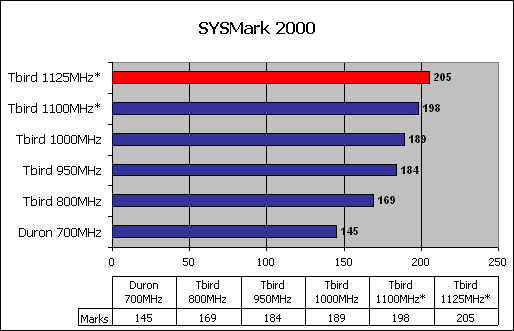 |
|
|
|
In the Forums... |
Posted: December 4, 2000 Written by: Tuan "Solace" Nguyen Overclocking With a flick of a pencil, I was able to unlock the 950MHz Thunderbird without a problem. At the beginning of this review, I hypothesized that the 950MHz would be able to reach 1.1GHz just like a 1GHz could. This is because both are based on the same architecture and core. Using the Asus A7V, I adjusted the clock multiplier to a setting of 10.5. The system booted and went into Windows without a problem. Then I rebooted and went back into the BIOS and adjusted the FSB setting to a cool 107MHz (effectively 214MHz). A clock multiplier of 10.5 with an FSB setting of 107MHz will give you 1125MHz. Our 950MHz booted without a hitch and proceeded to go straight into Windows at which point it proved to be rock solid. Our processor’s core voltage was set to 1.8V (default of 1.75v) and everything went smoothly. We were also using an Alpha PAL6035 heatsink with a Delta “black label” 38CFM fan. Let’s take a look at SYSMark 2000 again.  Tbird 1125MHz* = Overclocked 950MHz (10.5x107) Tbird 1100MHz* = Overclocked 1000MHz (11x100) You can see that there is a big improvement from overclocking the 950MHz Thunderbird. It ran solid as a rock at 1125MHz and proved my hypothesis correct. With this type of improvement, it makes more sense to go with a 950MHz Thunderbird than a 1GHz. You may be saying, “Well, if I purchase the 1GHz, then I can overclock just as much and get an even bigger improvement.” Actually our 1GHz failed to function properly when I increased its frequency beyond 1125MHz -- even with a voltage setting of 1.85V. We also used a 1GHz Thunderbird and overclocked it using the its clock multiplier to 1.1GHz to show you how an actual 1.1GHz Thunderbird would perform. We didn’t overclock the FSB because we wanted to maintain the default settings of what an actual 1.1GHz system would have. |
||
|
| |||
|---|---|---|---|